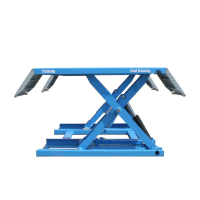Installation 25
Kwik Bay
7.5 Pneumatic System Connection
When routing the pneumatic line, make sure that the line is
clear of any moving part. Failure to do so may result in safety
lock failure which may result in damage or personal harm.
The pneumatic supply at site (to which the pneumatic system of the lift
is connected) must be equipped with a servicing unit composed of water
separator, lubricator and pressure reducer. These devices can be supplied by the
manufacturer on request.
For the connection of the pneumatic lines proceed as follow:
• Connect the pneumatic lines pre-assembled on the lift to the solenoid air
valve in the control unit according to the pneumatic plan (fi g. 6);
• Connect the pneumatic system of the lift to the pneumatic supply at site;
• Check the pneumatic control operations for proper performance.
7.6 Start
During this procedure, DO NOT attempt to raise the lift with
any load.
• Make sure all pins and bolts to insure proper mounting
• Make sure the electrical system feeding voltage is equal to that specifi ed in
the nameplate on the motor
• Make sure the electric connections are in compliant with diagrams Fig. 5
• Make sure no leakage or blow-up in hydraulic line
• Make sure the working area is free from people and objects
• Grease sliding seats of blocks placed under platforms and on bases
• Pour oil in the tank (about 5 liters more than one time)
• Verify that the control unit is powered
• Verify that the motor direction of rotation is that shown on the label by
pushing the lifting button. IF MOTOR GETS HOT OR SOUNDS PECULIAR,
STOP IMMEDIATELY AND RECHECK THE ELECTRIC CONNECTIONS
• Raising the lift slowly by pressing the lifting button until cylinders bottom
out and the lift stops. DO NOT continue pressing button after lift reaches
full height. Damage to motor can occur if continued.
• Repeat raise and lower the lift completely at least 3 times to equalize the
oil pressure in each cylinder.

